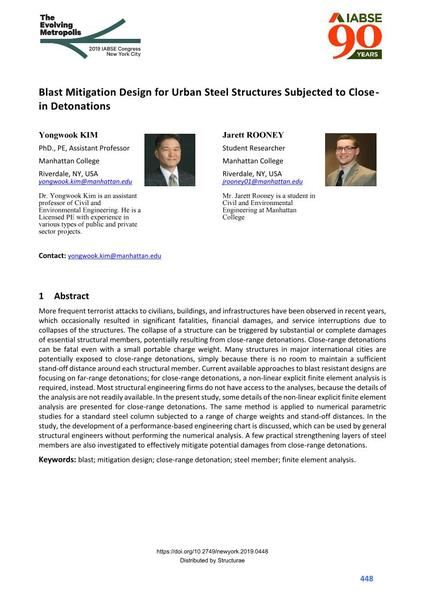Blast Mitigation Design for Urban Steel Structures Subjected to Close- in Detonations

|
|
|||||||||||
Bibliographic Details
| Author(s): |
Yongwook Kim
(Manhattan College)
Jarett Rooney (Manhattan College) |
||||
|---|---|---|---|---|---|
| Medium: | conference paper | ||||
| Language(s): | English | ||||
| Conference: | IABSE Congress: The Evolving Metropolis, New York, NY, USA, 4-6 September 2019 | ||||
| Published in: | The Evolving Metropolis | ||||
|
|||||
| Page(s): | 448-452 | ||||
| Total no. of pages: | 5 | ||||
| DOI: | 10.2749/newyork.2019.0448 | ||||
| Abstract: |
More frequent terrorist attacks to civilians, buildings, and infrastructures have been observed in recent years, which occasionally resulted in significant fatalities, financial damages, and service interruptions due to collapses of the structures. The collapse of a structure can be triggered by substantial or complete damages of essential structural members, potentially resulting from close-range detonations. Close-range detonations can be fatal even with a small portable charge weight. Many structures in major international cities are potentially exposed to close-range detonations, simply because there is no room to maintain a sufficient stand-off distance around each structural member. Current available approaches to blast resistant designs are focusing on far-range detonations; for close-range detonations, a non-linear explicit finite element analysis is required, instead. Most structural engineering firms do not have access to the analyses, because the details of the analysis are not readily available. In the present study, some details of the non-linear explicit finite element analysis are presented for close-range detonations. The same method is applied to numerical parametric studies for a standard steel column subjected to a range of charge weights and stand-off distances. In the study, the development of a performance-based engineering chart is discussed, which can be used by general structural engineers without performing the numerical analysis. A few practical strengthening layers of steel members are also investigated to effectively mitigate potential damages from close-range detonations. |
||||
| Keywords: |
finite element analysis FEA blast mitigation design close-range detonation steel member
|
||||
